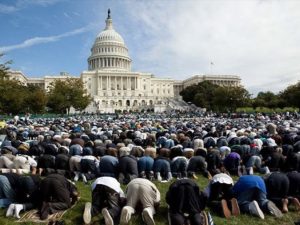by WorldTribune Staff, October 4, 2016
Census Bureau data show that of the more than 42 million immigrants, legal and illegal, in the United States, the largest percentage increase in immigrants is from majority Muslim nations.

According to a report by Center for Immigration Studies (CIS) authors Steven A. Camarota, director of research, and Karen Zeigler, a demographer:
“The sending countries with the largest percentage increases in immigrants living in the United States from 2010 to 2014 were Saudi Arabia (up 93 percent), Bangladesh (up 37 percent), Iraq (up 36 percent), Egypt (up 25 percent), and Pakistan, India, and Ethiopia (each up 24 percent).”
The CIS report noted that “new immigration plus births to immigrants added more than eight million people to the U.S. population between 2010 and 2014, accounting for the overwhelming majority of population growth.
Immigrants now account for more than one in eight U.S. residents, the report said, with children from immigrant households now accounting for “nearly one in four public school students, almost one-third of children in poverty, and one-third without health insurance, creating enormous challenges for the nation’s schools, health care system, and physical infrastructure.”
Key highlights from the report:
- The nation’s 42.4 million immigrants (legal and illegal) in 2014 is the highest number ever in American history. The 13.3 percent of the nation’s population comprised of immigrants in 2014 is the highest percentage in 94 years.
- States with the largest percentage increases in the number of immigrants from 2010 to 2014 were North Dakota (up 45 percent), Wyoming (up 42 percent), Montana (up 19 percent), Kentucky (up 15 percent), New Hampshire (up 14 percent), and Minnesota and West Virginia (both up 13 percent).
- In 2014, 49 percent of maids, 47 percent of taxi drivers and chauffeurs, 33 percent of butchers and meat processors, and 35 percent of construction laborers were foreign-born.
- Almost one in three children (under age 18) in poverty have immigrant fathers.
- There are 64 public school students per 100 immigrant households, compared to 38 for native households. Because immigrant households tend to be poorer, immigration often increases school enrollment without a corresponding increase in the local tax base.
